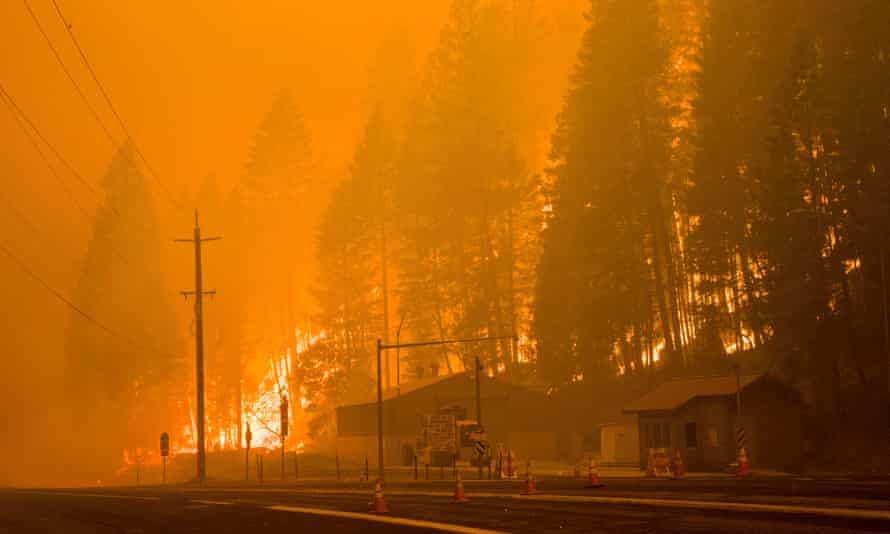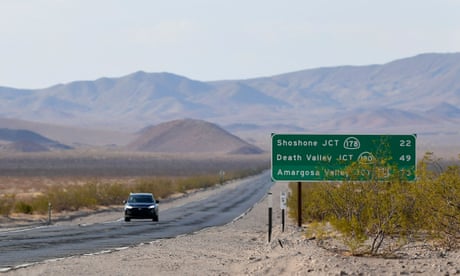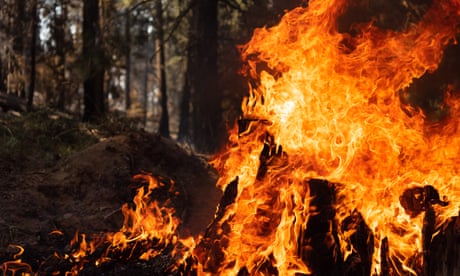Extract from The Guardian
California’s biggest fire destroys multiple homes while other blazes batter the American west.

The Dixie fire continues to burn in California on Saturday.
First published on Sun 25 Jul 2021 23.35 AEST
As California’s biggest wildfire destroyed multiple homes, flames racing through rugged terrain, and as numerous other blazes battered the American west, the governor of Oregon said the climate crisis was “like a hammer hitting us in the head”.
“We have to take action,” Kate Brown said.
In California, the Dixie fire, which started on 14 July, had already leveled more than a dozen buildings when it tore through the tiny community of Indian Falls after dark on Saturday.
A new damage estimate was not immediately available but fire officials said the blaze had charred 298 square miles of timber and brush in Plumas and Butte counties and was 21% contained.
“It has been burning in extremely steep canyons, some places where it is almost impossible for human beings to set foot on the ground to get in there,” he said. “It’s going to be a long haul.”
Crews made progress by setting fires to rob the main blaze of fuel, Carhart said. The fire prompted evacuation orders in several small mountain communities and along the west shore of Lake Almanor, a popular resort. About 10,000 homes were under threat.
The largest US wildfire, the Bootleg fire in southern Oregon, was nearly half-surrounded as more than 2,200 crew members worked in heat and wind, fire officials said. The blaze had slowed but thousands of homes remained threatened.
“This fire is resistant to stopping at dozer lines,” said Jim Hanson, a fire behavior analyst, in a news release from the Oregon Department of Forestry. “With the critically dry weather and fuels we are experiencing, firefighters are having to constantly reevaluate their control lines and look for contingency options.”
Brown, the Democratic governor of Oregon, spoke to CNN’s State of the Union.
“The harsh reality is that we’re going to see more of these wildfires,” she said. “They’re hotter, they’re more fierce and obviously much more challenging to tackle. And they are a sign of the changing climate impacts.
“So climate change is here, it’s real and it’s like a hammer hitting us in the head. And we have to take action.”
In California, Governor Gavin Newsom declared a state of emergency for four northern counties because of wildfires causing “conditions of extreme peril to the safety of persons and property”. The proclamation opened the way for more state support.
Brown praised the federal government.
“The Biden-Harris administration has stepped up,” she said. “They understand that we need a comprehensive, collaborative approach to tackling wildfire. We obviously always continue to need additional financial resources and boots on the ground. But that’s something we will have a conversation about post-wildfire season.”
Random, short-term and natural weather patterns are being heightened by long-term, human-caused climate change. Global warming has made the west much warmer and drier in the past 30 years.
Brown said it was “incredibly important with climate change that we get into these forests and start doing the thinning and harvest and prescriptive burning, so that we can create healthier landscapes, landscapes that are more resilient to wildfire”.
In south-west Montana, officials were focusing on three fires amid forecasts of rising temperatures, low humidity and westerly winds that could produce explosive growth.
Crews were trying to protect about 200 homes and cabins and prevent the 44-square-mile Trail Creek blaze from reaching the Big Hole National Battlefield in Beaverhead county, fire spokesman Jason Nedlo said. The battlefield has been closed.
Five federal firefighters were in stable condition after winds blew a lightning-caused wildfire back on them in eastern Montana on Thursday. The five were building a defensive line at the Devil’s Creek Fire in Garfield county when the weather shifted.
Another high-priority blaze, the Alder Creek fire in south-west Montana, had charred more than 6,800 acres and was 10% contained. It was threatening nearly 240 homes.

Heavy smoke from that blaze and the Dixie fire lowered visibility and threatened to ground aircraft providing support for fire crews. The air quality south of Lake Tahoe and in Nevada deteriorated to very unhealthy levels.
In north-central Washington, firefighters battled two blazes in Okanogan county that threatened hundreds of homes and caused hazardous air quality. In northern Idaho, east of Spokane, Washington, a small fire near the Silverwood Theme Park prompted evacuations. The park was back open on Saturday with the fire half-contained.
Weekend forecasts also called for a chance of scattered thunderstorms in California, Utah, Nevada, Arizona and elsewhere. Some could be dry thunderstorms that produce little rain but a lot of lightning, which can spark fires.
By Sunday more than 85 large fires were burning around the US. They had burned more than 1.4m acres.

No comments:
Post a Comment